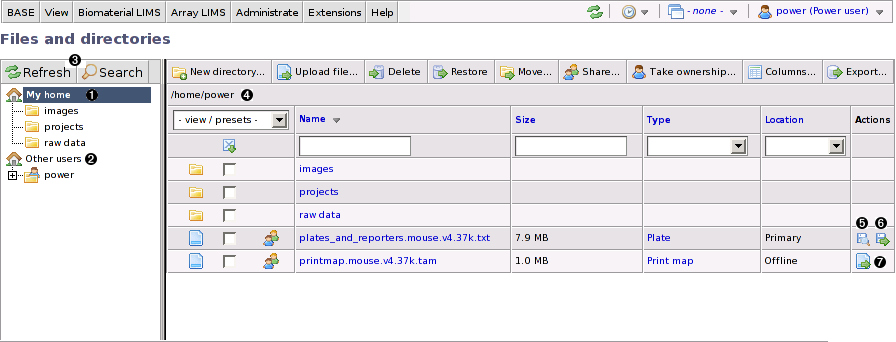Files in BASE are managed from the page at → . The basic layout on the page is the same as for all the other list pages in BASE but there are some differences e.g. there is a navigation tree to the left, used to browse the directory structure, and there are some buttons in the toolbar, that are special for files and directories. The figure below is a representation of the files and directories-page and is followed with a short description to some of the special functions.
- 1. Home directory for current user
This is the logged in user's home directory with sub directories. It is visible if the current user has a home directory and is then always located at the top of the navigation tree. More about this can be read in the section called “Home directory - 'My home'”. Click on a directory to display it's contents to the right or click on the plus sign to expand the directory and view the sub directories (no plus sign = no sub directories).
- 2. Other users
The other users' home directories that the current user has permission to read are listed here, including his/her own.
- 3. Button toolbar
The button toolbar contains functions that are relevent for the navigation tree. Use the button to update the directory tree, for example, after creating a new subdirectory. Use the button to search for files and directories no matter where they are located. The search form is displayed to the right and is the same as the usual file and directory listing, except that it will not show any files if there is no filter.
- 4. Current directory
Shows the full BASE path to current directory.
- 5. View a file's contents
A click on this icon will open the file's contents in a new window. If the browser does not has support to view the file there will be a dialog window to download the file instead.
- 6. Download file
Download the file to a local computer with this icon. The download will start in a new dialog window.
- 7. Re-upload a file
-
This icon is only visible for those files that have been moved offline and it can be used to re-upload the file to the BASE. Start to upload the file to the same position by clicking on the icon.
![[Note]](../../gfx/admonitions/note.gif)
Replace an existing file It is possible to re-upload file that are on-line, but this has to be done from the single-item view.
Browsing the BASE file system is done from the navigation bar by clicking on a directory in the tree to view it's contents. Both sub directories and files in the selected directory are showed. A directory with sub directories can be expand with a click on the plus-sign.
![[Note]](../../gfx/admonitions/note.gif) |
Browse a directory |
|---|---|
A directory can only be open from the navigation tree and never from the list. A click on a directory's name in the list will open the directory's edit window. |
The navigation tree contains of folders/directories that the logged in user has permission to read. At the top is the current user's home directory and under it is a folder with all accessible home directories.
The tree can be updated with the refresh-button at the bottom of the panel (the tree is not self-refreshing).
To make it easier for the logged in user to find his/her directory without having to scroll through the whole list of home directories, his or hers home directory is located at the top of the navigation tree under the My home folder.
![[Note]](../../gfx/admonitions/note.gif) |
No home directory |
|---|---|
Not all users have a home directory connected to their accounts. If My home is missing, it most certainly depends on that the current user account have not got a home directory. Home directories are managed by the administrator of the BASE server. |
Normally, a user is assigned limited disk space for files. More information about how much quota the current account has and how much of it that is occupied can be found at the account's home page, described in Section 6.1.3, “The home page”.
See Section 24.4, “Disk space/quota” for more information about the quota system.
